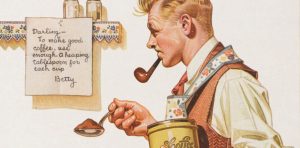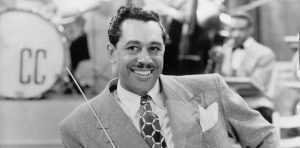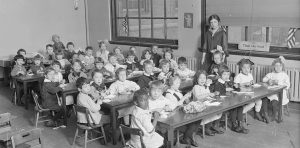The first of my articles for clothing brand House of Foxy‘s menswear line 20th Century Chap. This was published in March 2016.
This article is no longer online, so below is the original article in full.
Chap Talk – Fashion & Style Guide
The 1920s, ’30s and ’40s are the epitome of style, elegance and true ‘Hollywood’ glamour, not just for the ladies but for us men-folk too.
For men, the period is almost entirely dominated by the humble ‘lounge’ suit. Evolving out of the frock coat and trousers wore by the Victorian and Edwardian gentleman; the lounge suit represented a change in the pace of life towards frivolity and fun, focusing more on the need to move and take part in more leisurely activities. It drove a wedge between the uniforms of working life and the formality of evening wear and was championed by the younger, upcoming generations, disillusioned by convention and rules and spurred on by a need to grab life by the collar after the horrors they witnessed on the battlefields of the First World War.
It was this younger generation, as is often the case with fashion, that lead the trends, with most new fashions evolving out of those hotbeds of experimentation; colleges and universities. At the start of the inter-war period it was the British youth that led the way, but as the lead-up to war heightened this shifted across the Atlantic to America and stayed this way until the ’60s.
And so this pursuit of more leisurely activity called for a radical shift in men’s tailoring, with the need for more suitable attire to wear whilst holidaying or taking part in sports activities. Thankfully progress in manufacturing brought more and more fabrics to the market including lighter-weight fabrics such as linen, light-weight wool Gabardine or the famed ‘Palm Beach’ cloth – a blend of mohair and cotton, making a strong yet light and breathable fabric – which could be used for summer suits, trousers and sports jackets.
Advances in science helped shape the decades with the introduction of semi-synthetic fibres such as Rayon and Nylon, and the ability to print and weave intricate patterns and shapes into fabric, all of which led to more colourful and flamboyant items such as neckties and shirts for men to choose from and wear on a daily basis.
The sporting look also brought about the popularity of knitwear, especially as an alternative to the waistcoat, with high-profile style icons such as Edward Prince of Wales, Errol Flynn and Cary Grant all setting a trend for knits, especially fair-isle and cable knits.
1920s
Shirts
Although most men still wore the more traditional collarless shirt and detachable stiff collar during the ’20s, the trend for ‘soft’ fixed-collared shirts increased. First introduced by the military in World War One, these shirts offered men more freedom of movement and comfort and were seen as a definite rejection of the stuffy conventions of society.
Ties
A sense of frivolity and flamboyance could be expressed by the ’20s man with the necktie – bright colours, patterns and textures were all available, brought about by the use of silks and screen-printing techniques. This trend led to the use of accessories such as collar-bars or clips, which lifted the tie to more prominence.
Trousers
As the decade progressed, men’s trousers started to loosen and expand from the very straight ‘tubular’ style of the Edwardians, becoming increasingly wider as the fashion spread. The introduction of pleats helped to produce a more relaxed fit as well as cuffs at the bottom of the leg to give a ‘sporty’ look.
Men’s trousers were still usually held up with button braces (or suspenders), but later in the decade adjustable tabs helped cinch the waistband to hold trousers in place.
Suits
The now, well established, lounge suit offered a variety of options for the ’20s man. Suit jackets came in single and double-breasted, the single-breasted favoured by the younger man, and with either peaked or notched lapels. Jackets were also wide in the shoulder, tapering down towards the waist to create a slimmer silhouette. Other optical tricks used during this time were slanted pockets to draw the eye towards the middle of the body.
The number of pockets on a jacket was often seen as a status symbol – the more pockets the more expensively tailored the suit!
Waistcoats came in both collared and collarless styles and could be single or double-breasted. A particularly fashionable man might wear a doubled-breasted waistcoat under a single-breasted jacket.
The ’20s also saw a upsurge of patterns in suiting fabrics including check, pin-stripe, chalk-stripe, plaid and tweed to name but a few.
Hats
The hat was still very prevalent in the 1920s and particularly iconic for the decade was the straw Boater, reflecting the sporting style. Whilst the city gent favoured the Homburg, the workingman wore a Newsboy cap or a Flat-cap and those in service sported the Bowler. The ’20s man lucky enough to travel to warmer climes could sport a Panama.
Get the look:
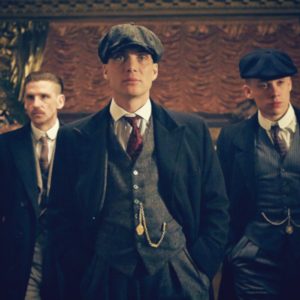
Classic ’20s:
Get the classic 1920s look, as seen in period TV shows such as Peaky Blinders or Boardwalk Empire, by teaming herringbone tweed trousers & matching waistcoat (or pinstripe for the American gangster look) with a striped collarless shirt, white stiff collar and studs, colourful silk tie and top it off with a newsboy cap. Don’t forget to add a pocket watch and chain to complete the look.

Sporting gent:
For the classic summertime ‘sporting’ look of the ’20s, grab a pair of cream or white trousers in cotton drill or linen, a white or pastel coloured soft-collar shirt, knitted tie (preferably horizontal stripped), and a straw boater. Add a cable-knit jumper or navy blazer and you are ready for a punt along the river.
1930s
Shirts
The ’30s saw the prevalence of a style of shirt first introduced in the ’20s – the spear-point collar. Originally seen as a ‘fashion’ item, with very long points to the collar, the spear-point settled down to a sensible length and became the go-to item for the stylish gent. This style of collar, like the soft-collars of the 1920s, could be held together with a collar-bar to give the tie emphasis.
Ties
The tie continued to be the standout item of clothing in the 1930s, with the width of the tie end increasing in size. Advances in production also meant more intricate patterns and shapes could be printed directly onto the tie or weaved in geometric patterns using brocade.
Trousers
Although first introduced in 1917 it took a while for men to get to grips with the latest evolution of the trouser – belt loops! More and more men in the ’30s started to belt their trousers, especially in the summer months, although a good proportion of men still held onto their braces and refused to switch. Other experiments included extending the waistband upwards to create a drop-belt-loop effect or even higher in a double waistband with all the additional adjusters, buttons and crossover straps to secure them in place without braces.
Suits
The ’30s saw more aids to the male figure starting to be introduced to suits, belt-backs on jackets to help draw-in the silhouette and vents and pleats added into the sides and backs to aid movement (sometimes called an ‘action-back’). We also see the peak-lapel become more horizontal across the chest heading towards the now iconic look of the ’40s.
Hats
The ’20s trend of Boaters, Homburgs and Newsboys is almost entirely replaced in the 1930s with the Trilby or Fedora, at least for those men still wearing hats!
Shoes
As with belt loops, another style that took a while to take hold was the co-respondent shoe, a two-tone variation of the oxford or brogue. The adoption of this style of shoe led to a number of variations in the ’30s, including two-tone versions of gibsons and bluchers, and evolved into the saddle shoe, worn by both sexes.
Get the look:

Classic ’30s:
Without doubt, the classic look of the 1930s gent was the double-breasted wool suit. Add a striped spear-point collar shirt, a silk-brocade tie with collar bar, and finish the look off with oxfords (or if your more daring, co-respondent shoes) and a high-crown fedora.
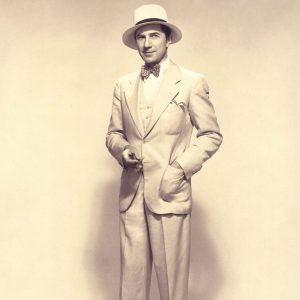
Summer style:
The epitome of summer style for the ’30s man is the three-piece single-breasted linen suit (or if you are lucky enough to find one – a Palm Beach suit), add in a white spear-point shirt, navy polka-dot bow tie, navy and cream saddle shoes and top it all off with a rakishly angled Panama hat.
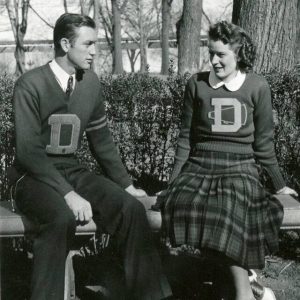
American Collegiate style:
Like their Oxford counterparts in the ’20s American students of the ’30s often sported the most up-to-date style, for example: double-height waistband trousers with a wide 28″ cuff bottom. Add in a crisp white spear-point shirt, colourful screen-printed rayon tie and a letterman sweater or cardigan; don’t forget to pomade that hair into a neat parting to complete the look.
1940s
The onset of war and disruptions to the importation of cloth introduced the need for clothes rationing (at least this was the case in Britain) and so the ’40’s look can be seen as a miss-match of older styles from the 1930s mixed in with newer items produced by “Controlled Commodity” utility brand clothing bearing the board of trace’s CC41 label. The spreading conflict in mainland Europe effectively halted any progression of style there until after the war ended in 1945 (and beyond) so the iconic style prevalent in the ’40s is of the British and American man (not counting the servicemen of course).
Shirts
Many working men continued to wear the ’30s style spear-point fixed collar shirts, but the utility branded clothing brought about a return to the detachable collars of the ’20s, albeit this time with a pair of matching cloth collars in any style, including spear-point. These limitations of available cloth also lead to many more styles of ‘harder-working’ fabrics introduced such as the semi-synthetic rayon or the brushed cotton and chambray used in service uniforms.
Ties
Whilst the British man kept a sense of austerity with their plain, subtle-patterned or school-striped ties, our American cousins continued to be more and more flamboyant with their tie fabrics and patterns including a fashion for hand-painted designs on increasingly wider neckties.
Suits
Whilst early CC41 suits continued to be double-breasted, later reform called for more limitation on cloth, meaning single-breasted notch-lapel became the norm for men’s suits. Men were also encouraged to lose the turn-ups on their trousers.
Over in the U.S. men saw the introduction of more ‘sports’ styles of jacket, often nicknamed the ‘Hollywood’, as well as mix-and-match suits meaning you could wear the trousers of one suit with the jacket of the other.
Knitwear
Another style re-emerging from the past to become almost a mainstay was knitwear, especially the tank top and knitted waistcoat. Many of these were hand knitted as the ‘Knit for Victory’ drives produced warm clothing for many men in service. Fair-isle style were particularly prevalent as it meant you could use up lots of old bits of wool left over from other projects.
Hats
Where worn, the fedora and trilby still remained kings of the hat kingdom, but many men now didn’t bother with hats at all and only really wore them in adverse weather.
Get the look:
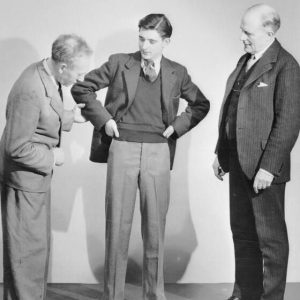
British ’40s:
The classic British look of the ’40s was the single-breasted suit, teamed with a plain or fair-isle tank top. Wear this with a spear-point shirt and stripped tie or a collarless shirt and no jacket for a more relaxed workingman’s look.
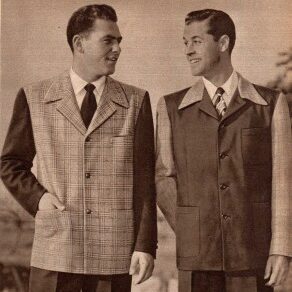
American ’40s:
For a classic 1940s American look, team a pair of dark ‘slacks’ with a two-tone sports jacket over a crisp white shirt and hand-painted wide ended tie. Finish the look with some two-tone apron-fronted gibson shoes.
